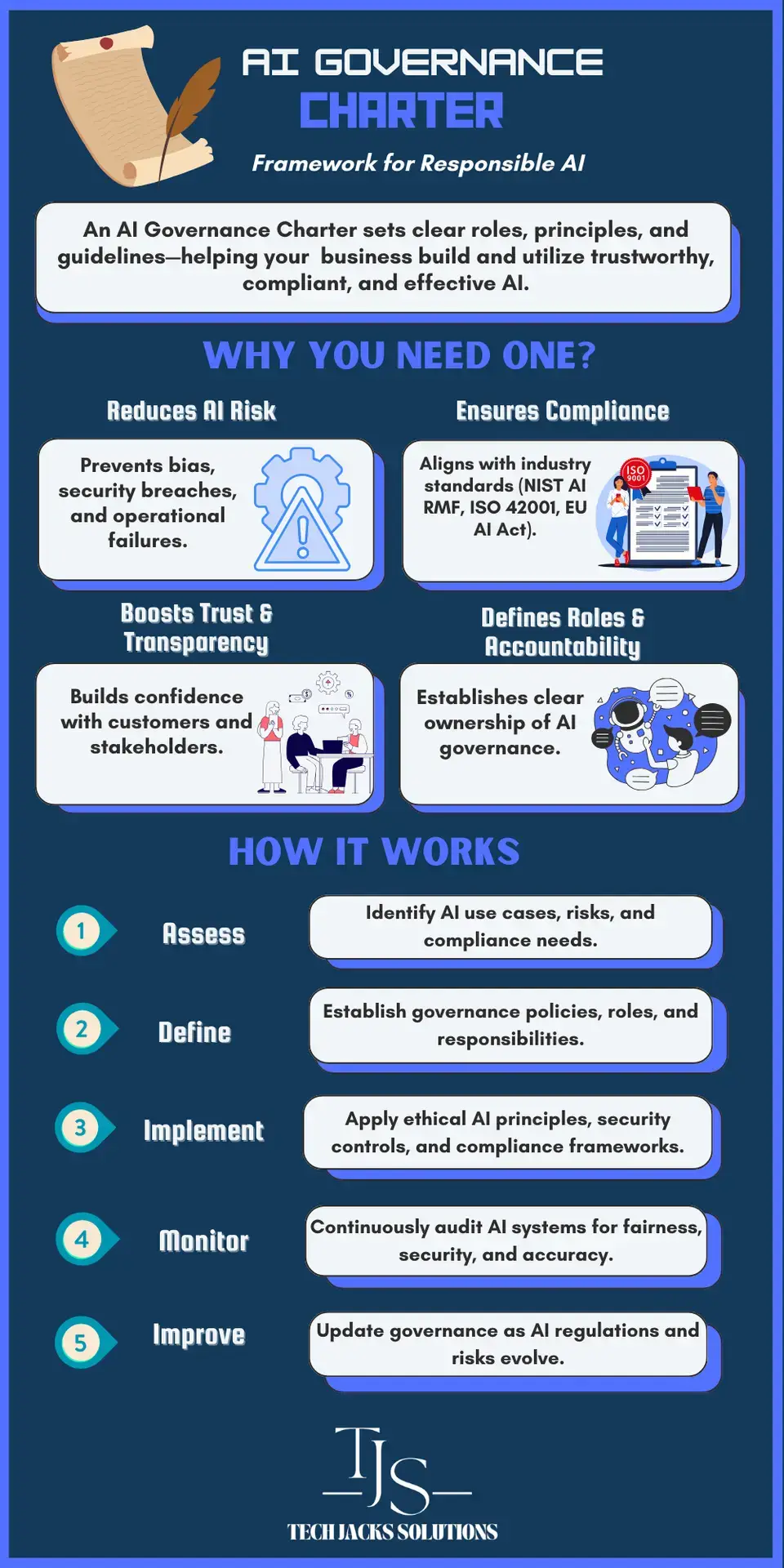AI Governance Charter
An AI Governance Charter is a foundational document that defines the mission, scope, roles, responsibilities, and authority of an organization’s AI governance structure. It is a formal declaration of how AI will be managed, who is accountable, and what principles and processes will guide oversight.
Its Core Value Lies In:
- Clarity of Authority
Clearly establishes who is responsible for approving, overseeing, or escalating AI-related decisions. This typically includes appointing a Chief AI Officer or forming a dedicated governance committee to ensure robust oversight. These roles are tasked with monitoring AI initiatives, setting priorities, and responding to challenges or potential risks swiftly and effectively. - Transparency and Accountability
Promotes seamless collaboration among compliance, security, legal, product, and technical teams, ensuring alignment across all business functions. By fostering open communication and shared responsibility, this principle creates a system where issues or concerns are flagged early and resolved efficiently, reducing the risk of siloed decision-making. - Regulatory and Ethical Alignment
Connects internal governance practices to established external frameworks, including the NIST AI RMF, EU AI Act, OECD AI Principles, and the GAO AI Accountability Framework. This alignment helps ensure compliance with rapidly evolving regulations while maintaining ethical integrity. It also promotes trustworthiness in AI operations, both internally and with external stakeholders. - Operational Guidance
Outlines detailed processes for submitting AI-related requests, assessing and mitigating risks, and tracking or auditing AI applications throughout their lifecycle. This framework provides step-by-step guidelines for managing AI systems, ensuring they remain aligned with organizational objectives, regulatory requirements, and ethical standards. Regular audits and risk assessments are key to maintaining control and adaptability in a changing environment. - Strategic Guardrails
Offers leadership a structured platform to define the organization’s core values, establish clear risk tolerance levels, and set ethical boundaries for AI development and deployment. These guidelines help create a cohesive vision for AI, ensuring that its use supports long-term organizational goals while minimizing potential harm or misuse. By providing strategic direction, companies can innovate responsibly and adapt to industry changes effectively.
Authoritative Frameworks That Recommend AI Governance Charters or Equivalents
Here are leading frameworks and resources that directly or indirectly recommend formal governance documentation such as charters:
NIST AI Risk Management Framework (AI RMF)
- What it says: The “Govern” function explicitly calls for organizational policies, processes, and structures that establish roles, accountability, and oversight for AI.
- Charter Alignment: NIST implies the need for a documented governance structure, including committees and clear ownership — core components of a charter.
- Link: NIST AI RMF Official Page
Cloud Security Alliance (CSA) – AI Organizational Responsibilities
- What it says: Recommends creating governance committees, RACI role matrices, and formalized governance charters for AI program oversight.
- Link: CSA AI Governance Working Group
GAO AI Accountability Framework
- What it says: Under the Governance principle, the GAO stresses the importance of defined roles, delegated authority, and documented goals — all typically defined in a charter.
- Link: GAO AI Framework Report (GAO-21-519SP)
OECD AI Principles
- What it says: Emphasizes transparent and accountable governance mechanisms for AI systems. Encourages organizational readiness and oversight structures.
- Link: OECD AI Principles
ISO/IEC 38507:2022 (Governance of IT — AI Use)
- What it says: Provides guidance for the governance of AI within organizations, including how to embed AI-specific considerations into corporate governance frameworks.
- Purchase Link: ISO/IEC 38507 Abstract
Creating an AI Governance Charter isn’t just a CYA activity. It’s a strategic asset. A governance charter helps to ensure your organization isn’t operating AI projects in silos or shadow IT but instead under a cohesive, policy-driven model. As AI regulations intensify, a clear governance charter helps demonstrate intent, diligence, and defensibility. Don’t get caught up in the repeated patterns of sub-optimal process and governance. Embrace the new AI paradigm and get things started on the right foot for once. It may even save you a headache or two in the future.
Thanks for checking out the article and visiting our website. All of your support is valued and appreciate it! Check our our article on the 5 W’s of AI Governance below!


